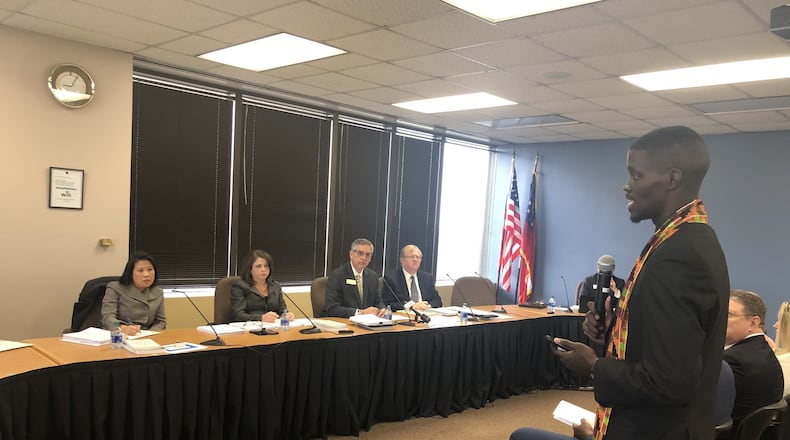Georgia’s election board rejected a proposal Wednesday that could have resulted in long lines of voters, instead introducing a plan to require more voting machines during this year’s high-turnout presidential election.
Still, the State Election Board’s proposed rules won’t provide as many voting machines as mandated by a state law passed last year, which called for one voting booth for every 250 voters in each precinct. Election officials said they will likely try to change that law during this year’s legislative session.
With a new voting system being rolled out during the March 24 presidential primary, the State Election Board approved rules for the state's voting machines and proposed several other changes dealing with absentee ballot rejections, provisional ballots, paper ballot backups and accessibility options for people with disabilities.
The board’s most consequential decision determined how many voting machines are available in each precinct on Election Day.
“We’re going to err on the side of short lines, not long lines,” said Secretary of State Brad Raffensperger, the chairman of the board. “We want to make sure we move people through the lines so the lines are less than 30 minutes.”
During the 2018 election, some voters in metro Atlanta precincts waited more than three hours to cast their votes in the race for governor between Republican Brian Kemp and Democrat Stacey Abrams. The lines, caused by heavier-than-expected turnout and an inadequate number of voting machines, contributed to an ongoing federal lawsuit over obstacles to voting in Georgia.
This year, Raffensperger said county election officials should prepare for even higher turnout, likely exceeding 5 million voters casting ballots on unfamiliar voting machines.
Voters will make their choices on touchscreens, which are connected to printers that create paper ballots. Then voters will take an extra step that didn't exist with the state's old electronic voting machines: They'll be asked to review their ballots for accuracy before inserting them into optical scanning machines for tabulation.
Voters confronted the State Election Board in opposition to the proposal that could have limited the number of Election Day voting machines in counties with many early voting locations.
The board declined to vote on that proposal. In populous areas such as Fulton County, just one machine would have been required in some precincts on Election Day.
“This rule gives permission for counties to create long lines by withholding equipment for some or all precincts,” state Rep. Jasmine Clark, a Democrat from Lilburn, told the board.
Voters advocating for paper ballots filled out by hand told the board to abandon the state’s new electronic voting equipment.
“Will some voters find more machines and shorter lines, while others find fewer machines and longer lines?” asked Dana Bowers, a voter who organized a petition for hand-marked paper ballots in 2018.
The board’s new plan would require county election officials to account for early voters when deciding how many voting machines are needed on Election Day. One voting machine would be available for every 250 registered voters who didn’t participate in early voting. About half of Georgia voters cast their ballots early.
Fair Fight Action, a voting rights group suing the state, said state election officials should provide the number of voting machines required by state law.
“The secretary of state cannot violate or misinterpret this law and provide fewer machines,” said Seth Bringman, a spokesman for Fair Fight Action. “His excuses, delays and fairy tales need to end.”
The board also proposed several other election rules that will be available for public comment for the next 30 days before receiving final votes:
- County election officials must notify absentee voters within a day if their ballots are rejected after the close of the advance voting period, giving them time to correct errors and have their ballots counted. This rule would supplement a state law that says voters must be notified "promptly" after absentee ballot rejections.
- Blind voters would be able to bring technology to their precincts to help them read their printed-out paper ballots.
- Information sheets would tell voters their options for using a provisional ballot if they attempt to vote in the wrong precinct.
- Election officials would maintain an emergency supply of paper ballots, amounting to at least 10% of registered voters.
- Poll workers would be stationed at scanning machines to remind voters to check their ballots for accuracy.
About the Author
Keep Reading
The Latest
Featured




